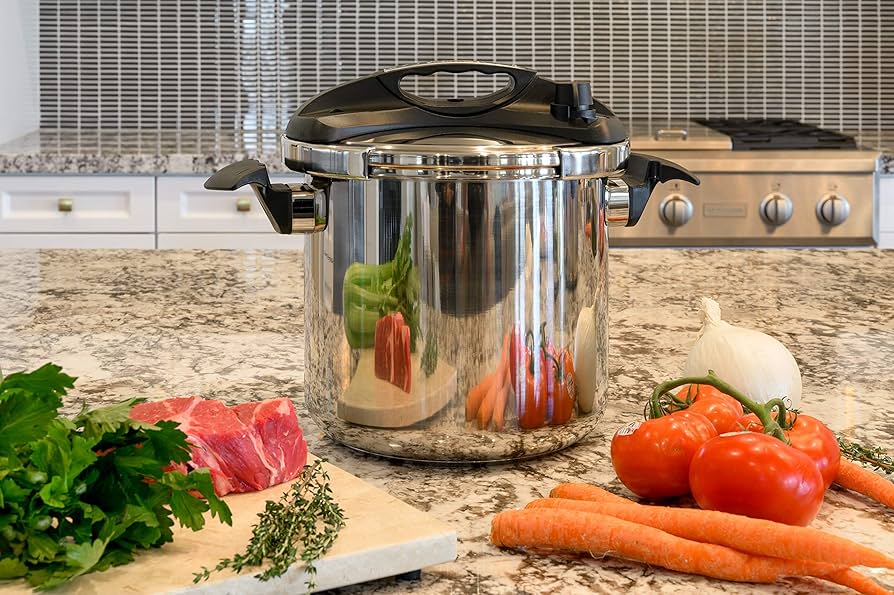Cooking tender and flavorful pig feet can be a challenging culinary endeavor, especially if you’re aiming to achieve that perfect melt-in-your-mouth texture. Fortunately, with the help of a pressure cooker, mastering the art of how to cook pig feet in a pressure cooker becomes a realizable and gratifying pursuit. This kitchen marvel not only saves time but also infuses your dish with deep, rich flavors that are sure to impress your taste buds.
The idea of cooking pig feet might seem daunting to some, given their unique texture and the lengthy time they usually require. However, with a pressure cooker, a cooking task that once demanded hours can now be completed in a fraction of the time. This modern kitchen tool not only helps tenderize the pig feet effectively but also maintains moisture and enhances flavors, making it an indispensable asset in any kitchen. Additionally, you can explore a variety of beginner pressure cooker recipes for more inspiration.

Understanding the Basics of Pig Feet
Pig feet, also known as trotters, are a traditional ingredient in many cuisines around the world, including Southern, Asian, and European culinary traditions. They bring a gelatinous texture to dishes due to their collagen and connective tissue content. To effectively prepare pig feet, it’s crucial to understand their culinary characteristics. Their unique texture makes them ideal for recipes that involve long, slow cooking processes that can break down the collagen, transforming it into tender meat and rich, savory broths.
Importance of Using a Pressure Cooker
The pressure cooker is a revolutionary tool that has redefined cooking processes and times. For the uninitiated, a pressure cooker is a sealed pot that uses steam pressure to cook food quickly. When it comes to pig feet, this method is especially beneficial as it allows the collagen to break down efficiently, yielding a dish with exquisite texture and flavor.
The Right Tools for the Job
Before diving into the cooking process, it’s important to gather the necessary tools and ingredients. An efficient cooking process starts with having the right equipment, such as a high-quality pressure cooker which can be your best friend in the kitchen. Alongside the pressure cooker, a sharp knife, sturdy cutting board, and reliable cookware cleaner will keep your cooking station primed for action.
Ingredients
- 2 lbs pig feet, cut into pieces
- 1 onion, chopped
- 3 cloves garlic, minced
- 2 bay leaves
- 1 tablespoon soy sauce
- 1 teaspoon salt
- 1 teaspoon black pepper
- 1 tablespoon olive oil
- 4 cups chicken or beef broth
- 1 tablespoon vinegar
- Optional: herbs and spices to taste
Preparation Before Pressure Cooking
Preparing pig feet for pressure cooking involves several crucial steps. Start by thoroughly cleaning the pig feet to remove any impurities or remnants. This can involve soaking them in a saltwater solution or boiling them briefly in a pot of water. This preliminary step is essential for achieving the clean, wholesome taste you’re aiming for. Make use of a well-maintained cutting board oil on your cutting board to facilitate easy chopping and prevent any natural odors from lingering, as you prepare the ingredients.
Setting Up the Pressure Cooker
Once your ingredients are prepped, the next step is setting up the pressure cooker. Begin by heating olive oil in the pressure cooker over medium heat. Add the onions and garlic, sauting them until they’re fragrant and the onions become translucent. This creates a savory base for the other flavors. Following this, add the prepared pig feet, allowing them to brown slightly for enhanced flavor.
With the pig feet browned, it’s time to introduce the liquid components that will assist in infusing the dish with flavors. Adding soy sauce and broth helps in achieving depth in taste, while vinegar can provide a subtle acidity that balances the richness of the dish, all while keeping it aromatic.
Cooking in the Pressure Cooker
With all ingredients in the cooker, it’s crucial to seal the lid correctly to ensure effective pressurization. Set the pressure cooker to high and cook the pig feet mixture for approximately 45 minutes to an hour. The exact time may vary depending on your specific pressure cooker model and the size of the pig feet, but this duration generally allows sufficient time for the connective tissues to break down.
It’s essential to allow proper release of the steam after cooking. You could use the natural release method for a slower and steady pressure decrease, which further softens your cooking meat. Alternatively, the quick release method hastens the process but is best suited when you’re confident about the tenderness of the meat.
Serving Suggestions
Once the pig feet have reached your desired level of tenderness, it’s time to serve your creation. This dish can be presented alongside diverse accompaniments, ranging from steamed rice to crusty bread, which will soak up the savory broth beautifully. Consider serving it with seasonal vegetables, either steamed or roasted, for a delightful pairing.
The succulent texture and intense flavor of the pig feet can be complemented using various herbs, spices, and additional seasonings before serving. They can be a standalone hearty main dish or a side dish depending on cultural preferences and serving sizes.

Conclusion
Cooking pig feet in a pressure cooker is not just efficient but an exciting journey that often transforms a challenging ingredient into a culinary delight. This method provides an ideal solution to achieve perfectly tender pig feet in a significantly reduced time compared to traditional techniques. With the right tools, such as a pressure cooker, you have the opportunity to elevate this dish to its full potential, creating an irresistible blend of tastes and textures that resonate with your culinary skills. This approach encapsulates the blend of tradition and modern innovation and is a testament to the continual evolution of cooking techniques that facilitate delicious meals and enjoyable experiences.
This article contains affiliate links. We may earn a commission at no extra cost to you.


